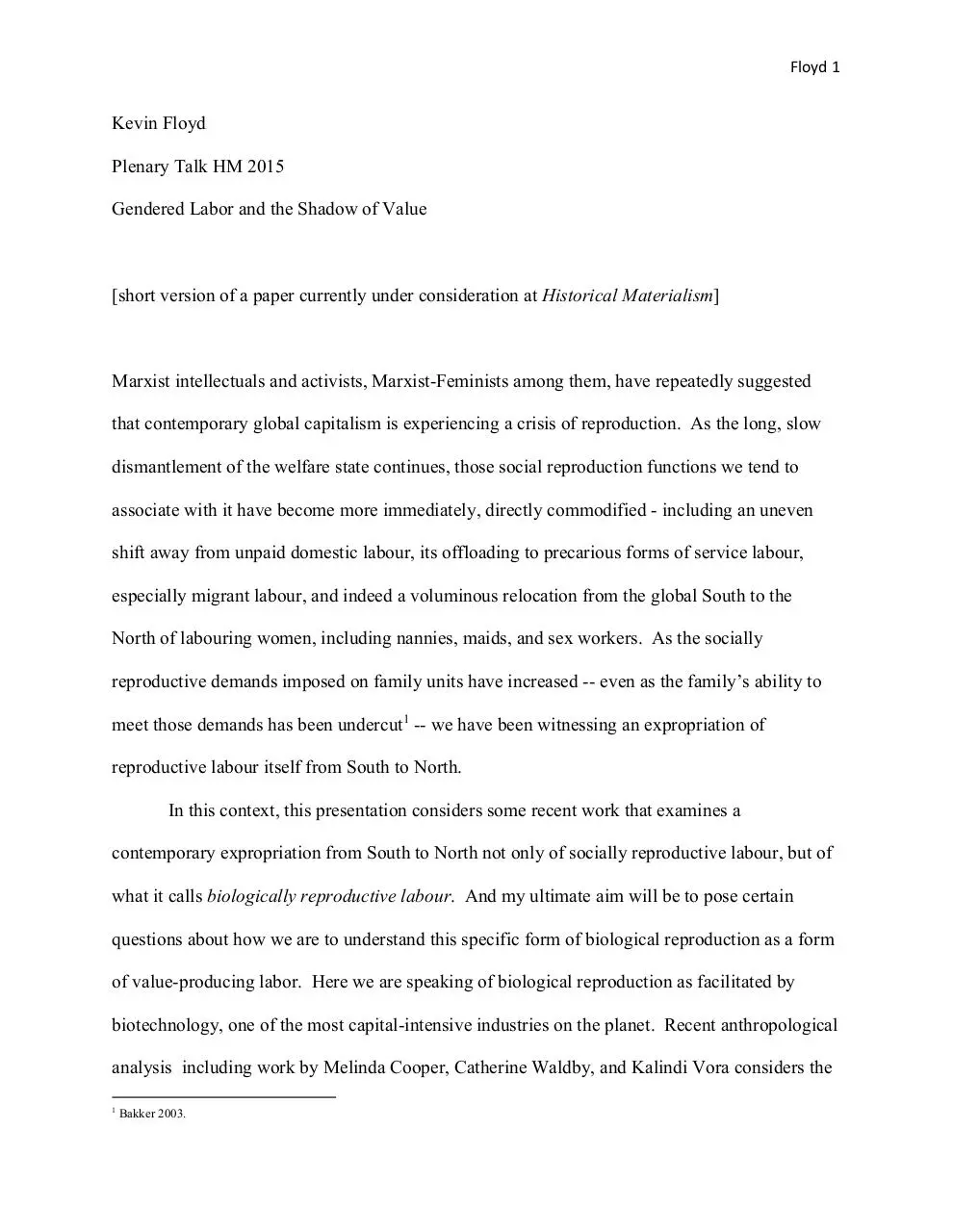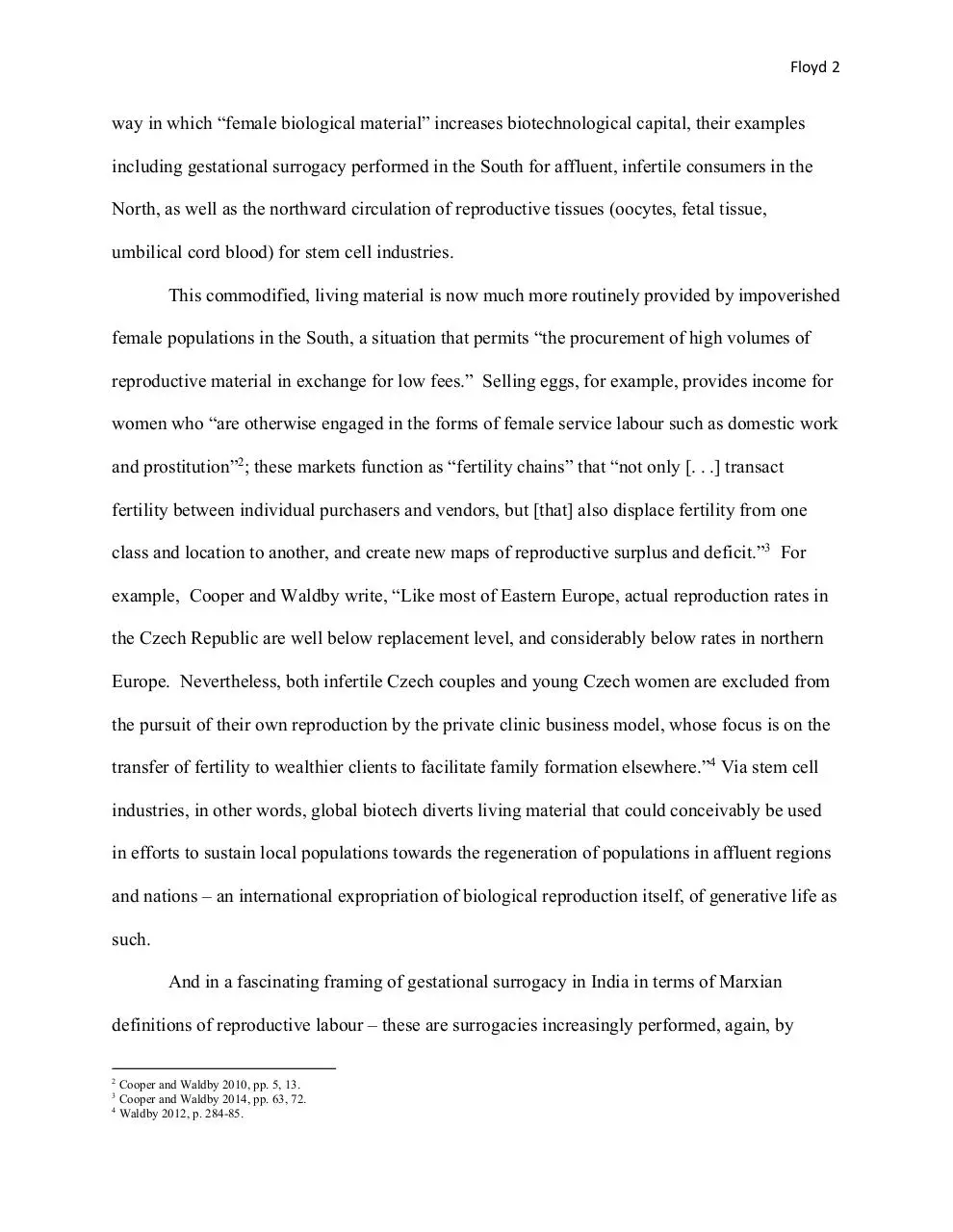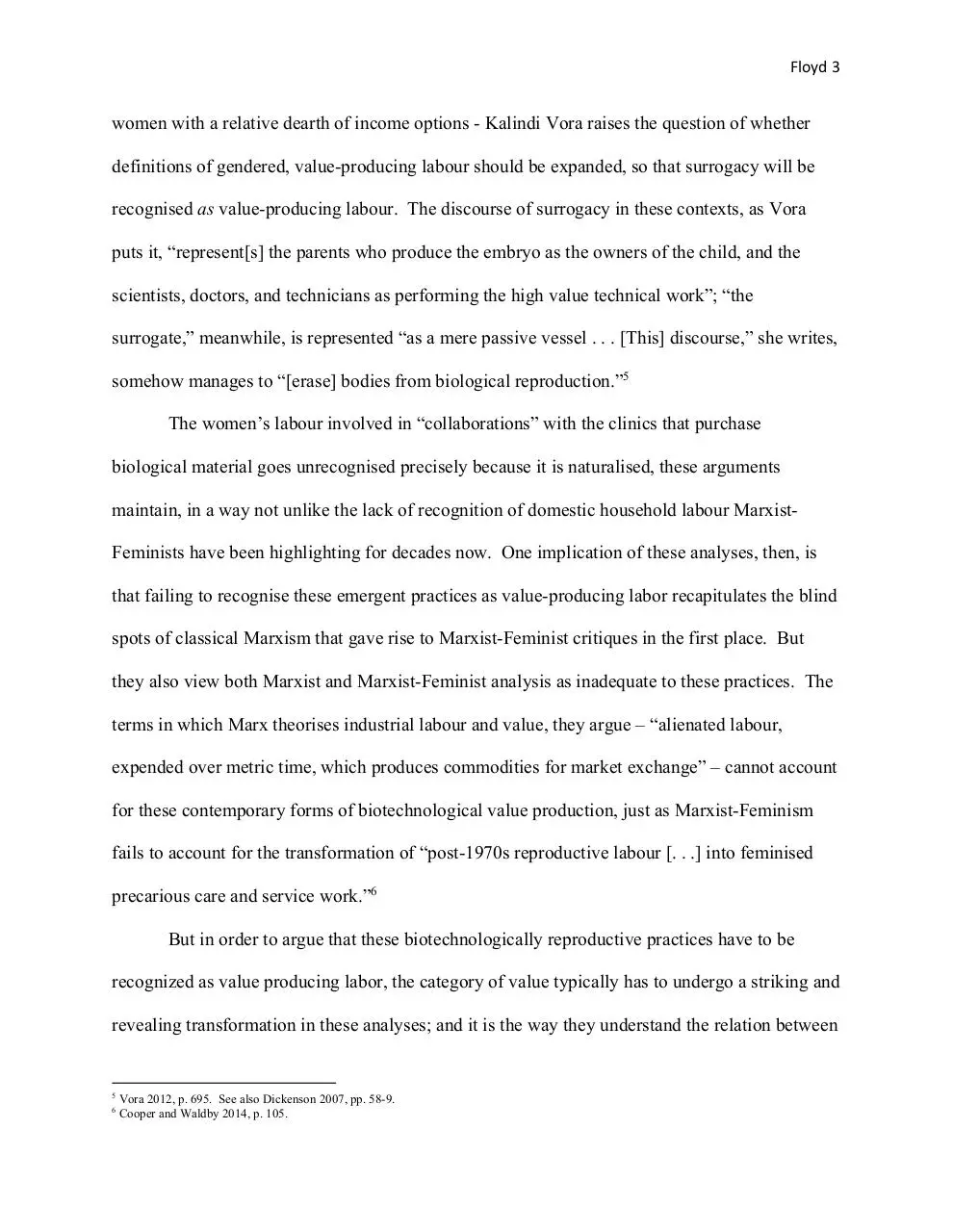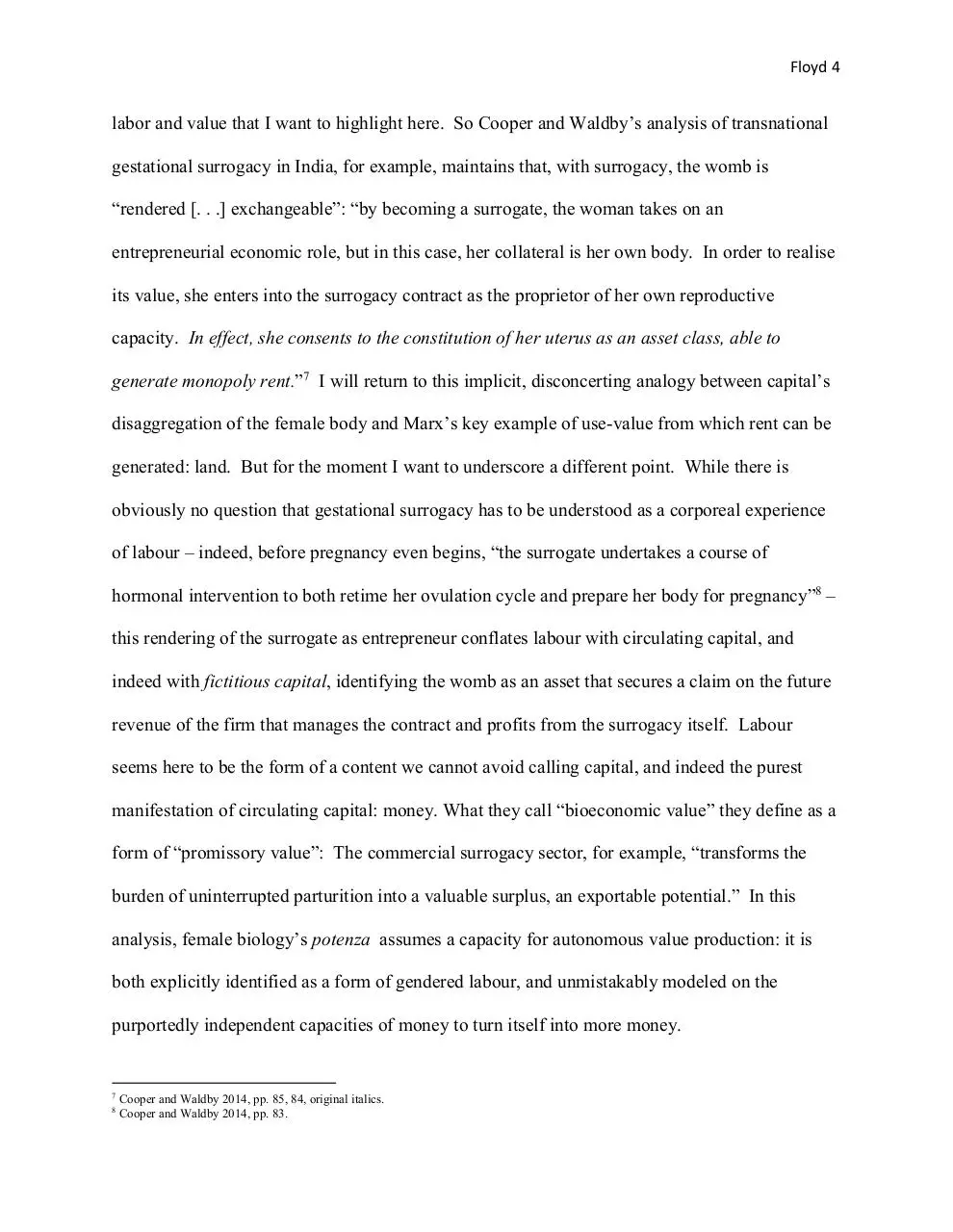kevin floyd (PDF)
File information
Title: Microsoft Word - Kevin Floyd Gendered Labour and the Shadow of Value HM Plenary Apr 2015.docx
Author: Sarah
This PDF 1.5 document has been generated by GIRDAC, and has been sent on pdf-archive.com on 03/08/2015 at 18:44, from IP address 184.151.x.x.
The current document download page has been viewed 630 times.
File size: 119.13 KB (11 pages).
Privacy: public file





File preview
Floyd 1
Kevin Floyd
Plenary Talk HM 2015
Gendered Labor and the Shadow of Value
[short version of a paper currently under consideration at Historical Materialism]
Marxist intellectuals and activists, Marxist-Feminists among them, have repeatedly suggested
that contemporary global capitalism is experiencing a crisis of reproduction. As the long, slow
dismantlement of the welfare state continues, those social reproduction functions we tend to
associate with it have become more immediately, directly commodified - including an uneven
shift away from unpaid domestic labour, its offloading to precarious forms of service labour,
especially migrant labour, and indeed a voluminous relocation from the global South to the
North of labouring women, including nannies, maids, and sex workers. As the socially
reproductive demands imposed on family units have increased -- even as the family’s ability to
meet those demands has been undercut1 -- we have been witnessing an expropriation of
reproductive labour itself from South to North.
In this context, this presentation considers some recent work that examines a
contemporary expropriation from South to North not only of socially reproductive labour, but of
what it calls biologically reproductive labour. And my ultimate aim will be to pose certain
questions about how we are to understand this specific form of biological reproduction as a form
of value-producing labor. Here we are speaking of biological reproduction as facilitated by
biotechnology, one of the most capital-intensive industries on the planet. Recent anthropological
analysis including work by Melinda Cooper, Catherine Waldby, and Kalindi Vora considers the
1
Bakker 2003.
Floyd 2
way in which “female biological material” increases biotechnological capital, their examples
including gestational surrogacy performed in the South for affluent, infertile consumers in the
North, as well as the northward circulation of reproductive tissues (oocytes, fetal tissue,
umbilical cord blood) for stem cell industries.
This commodified, living material is now much more routinely provided by impoverished
female populations in the South, a situation that permits “the procurement of high volumes of
reproductive material in exchange for low fees.” Selling eggs, for example, provides income for
women who “are otherwise engaged in the forms of female service labour such as domestic work
and prostitution”2; these markets function as “fertility chains” that “not only [. . .] transact
fertility between individual purchasers and vendors, but [that] also displace fertility from one
class and location to another, and create new maps of reproductive surplus and deficit.”3 For
example, Cooper and Waldby write, “Like most of Eastern Europe, actual reproduction rates in
the Czech Republic are well below replacement level, and considerably below rates in northern
Europe. Nevertheless, both infertile Czech couples and young Czech women are excluded from
the pursuit of their own reproduction by the private clinic business model, whose focus is on the
transfer of fertility to wealthier clients to facilitate family formation elsewhere.”4 Via stem cell
industries, in other words, global biotech diverts living material that could conceivably be used
in efforts to sustain local populations towards the regeneration of populations in affluent regions
and nations – an international expropriation of biological reproduction itself, of generative life as
such.
And in a fascinating framing of gestational surrogacy in India in terms of Marxian
definitions of reproductive labour – these are surrogacies increasingly performed, again, by
2
Cooper and Waldby 2010, pp. 5, 13.
Cooper and Waldby 2014, pp. 63, 72.
4
Waldby 2012, p. 284-85.
3
Floyd 3
women with a relative dearth of income options - Kalindi Vora raises the question of whether
definitions of gendered, value-producing labour should be expanded, so that surrogacy will be
recognised as value-producing labour. The discourse of surrogacy in these contexts, as Vora
puts it, “represent[s] the parents who produce the embryo as the owners of the child, and the
scientists, doctors, and technicians as performing the high value technical work”; “the
surrogate,” meanwhile, is represented “as a mere passive vessel . . . [This] discourse,” she writes,
somehow manages to “[erase] bodies from biological reproduction.”5
The women’s labour involved in “collaborations” with the clinics that purchase
biological material goes unrecognised precisely because it is naturalised, these arguments
maintain, in a way not unlike the lack of recognition of domestic household labour MarxistFeminists have been highlighting for decades now. One implication of these analyses, then, is
that failing to recognise these emergent practices as value-producing labor recapitulates the blind
spots of classical Marxism that gave rise to Marxist-Feminist critiques in the first place. But
they also view both Marxist and Marxist-Feminist analysis as inadequate to these practices. The
terms in which Marx theorises industrial labour and value, they argue – “alienated labour,
expended over metric time, which produces commodities for market exchange” – cannot account
for these contemporary forms of biotechnological value production, just as Marxist-Feminism
fails to account for the transformation of “post-1970s reproductive labour [. . .] into feminised
precarious care and service work.”6
But in order to argue that these biotechnologically reproductive practices have to be
recognized as value producing labor, the category of value typically has to undergo a striking and
revealing transformation in these analyses; and it is the way they understand the relation between
5
6
Vora 2012, p. 695. See also Dickenson 2007, pp. 58-9.
Cooper and Waldby 2014, p. 105.
Floyd 4
labor and value that I want to highlight here. So Cooper and Waldby’s analysis of transnational
gestational surrogacy in India, for example, maintains that, with surrogacy, the womb is
“rendered [. . .] exchangeable”: “by becoming a surrogate, the woman takes on an
entrepreneurial economic role, but in this case, her collateral is her own body. In order to realise
its value, she enters into the surrogacy contract as the proprietor of her own reproductive
capacity. In effect, she consents to the constitution of her uterus as an asset class, able to
generate monopoly rent.”7 I will return to this implicit, disconcerting analogy between capital’s
disaggregation of the female body and Marx’s key example of use-value from which rent can be
generated: land. But for the moment I want to underscore a different point. While there is
obviously no question that gestational surrogacy has to be understood as a corporeal experience
of labour – indeed, before pregnancy even begins, “the surrogate undertakes a course of
hormonal intervention to both retime her ovulation cycle and prepare her body for pregnancy”8 –
this rendering of the surrogate as entrepreneur conflates labour with circulating capital, and
indeed with fictitious capital, identifying the womb as an asset that secures a claim on the future
revenue of the firm that manages the contract and profits from the surrogacy itself. Labour
seems here to be the form of a content we cannot avoid calling capital, and indeed the purest
manifestation of circulating capital: money. What they call “bioeconomic value” they define as a
form of “promissory value”: The commercial surrogacy sector, for example, “transforms the
burden of uninterrupted parturition into a valuable surplus, an exportable potential.” In this
analysis, female biology’s potenza assumes a capacity for autonomous value production: it is
both explicitly identified as a form of gendered labour, and unmistakably modeled on the
purportedly independent capacities of money to turn itself into more money.
7
8
Cooper and Waldby 2014, pp. 85, 84, original italics.
Cooper and Waldby 2014, pp. 83.
Floyd 5
This modeling of surrogate labor on the temporality of finance, meanwhile, makes all the
more striking the failure of these analyses to account for the sheer determinate weight of debt on
regions of the globe where opportunities to perform wage labour are evaporating, where
increasing numbers of women are structurally compelled to sell the living materiality of their
bodies. International trafficking in sex slavery is often tacitly endorsed by debt-ridden
governments, for example, who have grown more and more dependent on tourism for national
income.9 Grace Chang adds that “austerity programs [. . .] effectively create systems of debt
bondage such that indebted nations must surrender their citizens, especially women, as migrant
labourers to first world nations in the desperate effort to keep up with debt payments [. . .]
through [. . .] remittances.” To paraphrase Chang, debt-ridden countries that can’t export goods
can sometimes export people instead.10 Gendered social reproduction, again, is financially
extracted from poorer countries to wealthier ones, in a kind of inverse reflection of the way in
which households in the North are steeped in debt. Fictitious capital saturates gendered social
reproduction in a double sense: the debt of relatively affluent households on the one hand, and
global debt’s radical exclusion of countless women from their own households, so that they can
perform domestic service labour elsewhere, on the other. In the present context this exclusion
would then also be manifest in the entrapment of women in regions increasingly externalised
from these forms of circulation, in that expanding territory fictitious capital is leaving behind. In
what may appear an obscene literalisation of the longstanding metaphorics that associate
women’s bodies with “nature,” and specifically with land – in the discourse of ova “harvesting,”
for example11 – those bodies are reduced to the status not of value producing labour, I would
argue, but of living raw material: if destitute women cannot circulate, the conjuncture of
9
Sassen 2000, pp. 518-19.
Chang 2000 pp. 4, 130-31; see also Sassen 2000, pp. 519-23.
11
See Dickenson 2007, p. 60.
10
Floyd 6
biotechnology and global debt has created circumstances in which biological substances
expropriated from their bodies apparently can.
The critique I want to offer of these analyses of ‘biologically reproductive labor’, then, is
twofold, and it turns on their analytic prioritizing of the category of labor over the category of
value. I would argue first of all, with Moishe Postone and Robert Kurz, that labour needs to be
understood as a specifically capitalist form of domination, the vital, compulsory form of activity
self-valorising value presupposes, a structural rather than an ontological position, a position both
internal and antagonistic to capital. The objective of labour is not to produce wealth or value but
to gain access to commodified means of subsistence, in order to go on labouring. Like so many
other analyses of labor, the arguments I have been rehearsing render labor as a transhistorical,
anthropological essence.
Kurz, moreover, joins his critique of this interpretive tendency with an account of the
contemporary crisis of value production. Value production he maintains, I think persuasively, is
currently hamstrung by an unsustainably high organic composition of capital, unprecedentedly
high productivity worldwide and the concomitant difficulty of absorbing significant additional
surplus labour. However much new forms of value production may be expanding, that
expansion is radically dwarfed in the present by the expansion of global debt on the one hand,
and global surplus populations on the other. Biotechnology, the “bioeconomy,” the post-Fordist
“new economy” more generally – these are all indicative of capital’s rising global value
composition, the multiform manifestations of which are familiar enough. These include the
displacement of new value production by profitmaking through the increasingly rapid circulation
of capital, its continuing rush into real estate, insurance, the latest barely thinkable financial
instrument (and into what many have already called the biotech bubble); the proletarianisation of
Floyd 7
the vast majority of the remaining global peasantry; the global expansion of mostly service sector
jobs (which accounted for more than half of global employment growth in 2013). The
gargantuan, sponge-like informal sector, meanwhile, tends to range between fifty and ninety
percent of total employment in the global South. And even where industrialisation has become
concentrated, in the so-called BRICS countries, “successful industrialization [. . .] is expected to
create fewer jobs in industry at any given level of income,” as the International Labor
Organization has put it, since “for late starters, the industrialization process tends to be more
capital intensive.”
As the production of new surplus value becomes a severe global problem for which there
appear to be no ‘spatial fixes,’ “the apparent naturalness of the labour abstraction,” Kurz writes,
“become[s] practically and theoretically obsolete.”12 The contemporary period threatens to
realise, on a global scale, Marx’s “absolute general law of capitalist accumulation”: Because
labour-saving technological innovations tend over time to become generalized across the
division of labour, the demand for labour tends to decline, a secular decline that is now clearly
global. This current tendency in value composition simply manifests what the Grundrisse
famously calls the “moving contradiction” of “capital itself,” which “presses to reduce labour
time to a minimum, while it posits labour time, on the other side, as sole measure and source of
wealth.”13
And just as these arguments naturalize labor, they also naturalize gender. We should
understand this contemporary extraction of biological reproduction, of “life itself,” as part of an
expanding horizon of what Roswitha Scholz calls “value-dissociation.”14 As Endnotes’ recent
specification of this concept argues, the determination of the valuation of labour power by the
12
Kurz 2011.
Marx 1973, p. 706.
14
Scholz 2014.
13
Floyd 8
value of the means of subsistence it requires implies that the domestic household labour needed
to transform those means of subsistence into labour power adds no new value to that commodity.
Within capital, these domestic activities are “structurally made non-labour”: in order for the
commodity labor power to have a value, the domestic labour that reproduces labour power has to
be dissociated from the circuit of value production.15 The gendering of domestic labour is a
matter, here, of domestic labour’s structural distance from the movement of value, not of the
ontological characteristics of specific activities.
And if reproductive labour today increasingly takes place within the value circuit, at least
in the North, this implies not a contracting but an expanding field of value-dissociation. The
familiar “feminisation of labour” thesis proposes not merely that more and more women have
entered the labour force, but the tendency toward increasingly informal, inexpensive forms of
labour, which are “presumed” to be associated with women workers: “irregular labour force
participation, willingness to work for low wages,” 16 relatively deskilled jobs, etc. In an era in
which cutting labour costs is of paramount concern, the tendency toward labour’s disposability is
thereby naturalised, to the extent that one believes, for example, that women are simply
biologically better equipped for the kinds of jobs on offer.
The obvious fact that expanding populations of men around the world find it increasingly
difficult to avoid these disposable jobs, if they are to access wages at all, tends to undercut this
naturalisation of gender difference. (Standing suggests that “there has been a convergence of
male and female patterns of labour force participation. While there has been an overall trend
toward more flexible, informal forms of labour, women’s situation has probably become less
15
16
Endnotes 2013, pp. 61-2.
Standing 1999, p. 585.
Floyd 9
informal, while men’s has become more so.”17) So against an account of gendered labour that
naturalises it – that depicts a production of value that operates according to some promissory
logic immanent to female biology, for example – “feminisation” in this sense refers not to any
ontological or “natural” condition, but to the contemporary tendency toward intensified labour
cost-cutting. I would point, in fact, toward a vanishing contemporary distinction between
feminised labour and surplus populations. The two are structurally inseparable – both are
fundamental to the contemporary devaluation of labour. “Feminisation” in this sense designates
not just eminently disposable labour, but the expanding surplus populations that make it so.
Indeed, what I earlier called the expropriation from South to North of generative life as
such takes a range of more gender-neutral forms. It is evident in the increasing subjection of
surplus populations to clinical trial participation, for example, which pharmaceutical companies
now regularly “outsource” to the South. The destitution that excludes them from circuits of drug
consumption produces strong economic motivations to risk their very corporeality as clinical trial
subjects. We are also now faced with a situation in which an earlier “chronic scarcity of cadaver
organs” has been alleviated, evolving into what Nancy Scheper-Hughes calls “a trade in ‘surplus’
body parts from living ‘suppliers’”: destitute peasants, refugees, migrant labourers, prisoners, the
homeless, the undocumented. Whereas scarcity was once a problem, there is now “no shortage
of desperate individuals willing to sell a kidney, a portion of their liver, a lung, an eye, or even a
testicle for a pittance.” Of the global “circulation” of kidneys, she writes that, generally, this
“circulation follows the established routes of capital from South to North, from poorer to more
affluent bodies, from black and brown bodies to white ones,” adding that “we can even speak of
organ donor versus organ recipient nations.” And Ann Anagnost describes the way in which, in
the 1990s, blood purchased from proletarianised peasants in Henan province, one of the most
17
Standing 1999, p. 600.
Download kevin floyd
kevin floyd.pdf (PDF, 119.13 KB)
Download PDF
Share this file on social networks
Link to this page
Permanent link
Use the permanent link to the download page to share your document on Facebook, Twitter, LinkedIn, or directly with a contact by e-Mail, Messenger, Whatsapp, Line..
Short link
Use the short link to share your document on Twitter or by text message (SMS)
HTML Code
Copy the following HTML code to share your document on a Website or Blog
QR Code to this page

This file has been shared publicly by a user of PDF Archive.
Document ID: 0000293326.